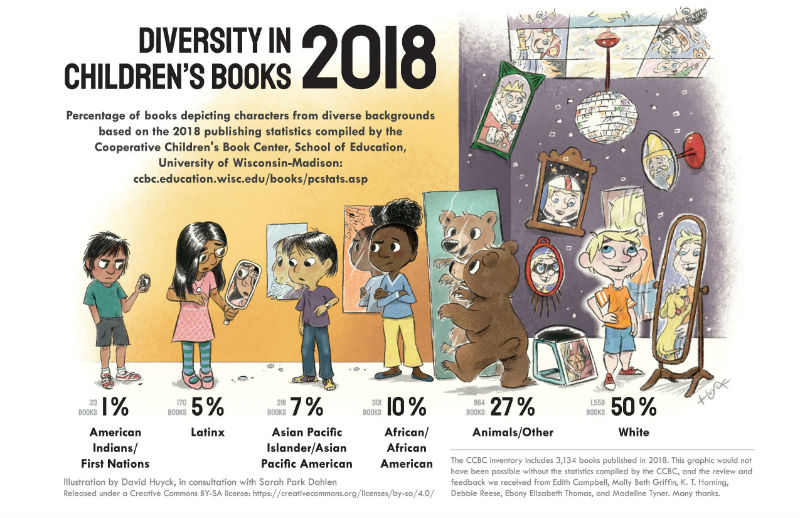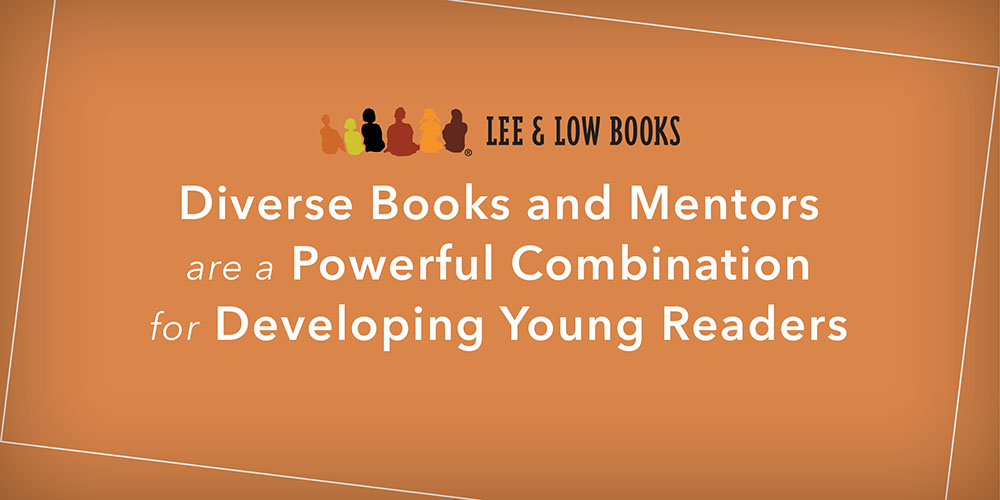In this guest blog post, educator Lindsay Barrett discusses the power and importance in having diverse books and mentors. Jill Eisenberg, director of curriculum and literacy strategy at Lee & Low Books, also discusses the role of diverse books in mentoring programs for developing readers. This blog post first appeared on Reading Partners.
Do you remember the first book that truly transported you into someone else’s life? What about the first book in which you really saw yourself? Reading and discussing diverse titles —titles varied in their portrayals of ethnicity, culture, religion, ability, family structure, gender, and living circumstances— can bolster students’ reading motivation and connection to books. It can build background knowledge, critical thinking, and social-emotional skills, all key drivers for students’ academic and personal success.
For young readers, particularly those who’ve struggled to develop reading skills and self-identify as readers, captivating diverse books can be catalysts that change the trajectories of their reading lives. Mentors can help students find these books and think deeply about them. In 1990, Rudine Sims Bishop authored a touchstone essay on the role of books as “Mirrors, Windows, and Sliding Glass Doors,“ which shaped the conversation on the power of diverse books to reflect readers’ experiences and expand their perspectives. Recently, author Uma Krishnaswami urged an extension of this analogy in her essay, “Why Stop at Windows and Mirrors? Children’s Book Prisms.” As prisms bend and refract light in different directions, diverse books allow readers to use fictional characters to “question the assumptions and practices of our own real world.”
How we choose and use diverse books matters

Huyck, David and Sarah Park Dahlen. (2019 June 19). Diversity in Children’s Books 2018. sarahpark.com blog. Created in consultation with Edith Campbell, Molly Beth Griffin, K. T. Horning, Debbie Reese, Ebony Elizabeth Thomas, and Madeline Tyner, with statistics compiled by the Cooperative Children’s Book Center, School of Education, University of Wisconsin-Madison: http://ccbc.education.wisc.edu/books/pcstats.asp. Retrieved from https://readingspark.wordpress.com/2019/06/19/picture-this-diversity-in-childrens-books-2018-infographic/
Mentors, working in concert with the organizations that support them, can help ensure diverse books get into young readers’ hands. Options for diverse books expand each year, but curating a diverse library requires conscious choice and consideration. Organizations such as We Need Diverse Books are leading the charge in promoting publication of diverse titles and connecting them to readers. A compelling 2018 infographic by Sarah Park Dahlen and David Huyck calls for continued effort to publish diverse books that avoid misrepresentation; poor quality or stereotypical diverse books can have the effect of distorted “funhouse mirrors.” The #OwnVoices book movement has gained traction in recent years, encouraging diverse stories to be told by those who share those identities.
Mentors can also actively guide readers in experiencing “many stories” through diverse books. Author Chimamanda Adichie’s popular TED talk, The Danger of a Single Story, is a call-to-action to avoid fostering a one-dimensional perspective on a group or topic. Sometimes a classroom library or reading list can seem diverse because it includes titles about slavery or prejudice. These stories can certainly be informative and inspiring, but it’s critical that students also have access to plenty of diverse books not about oppression or focused exclusively on difference. Books about everyday experiences and universal themes that happen to feature diverse characters and situations are equally, if not more, instrumental in helping children connect to books and establish a realistic, empathetic, and inclusive worldview. Children of every background navigate friendships, start school, celebrate milestones, and nurture dreams and aspirations, and the books we present must reflect this.
In a recent interview, Jill Eisenberg, director of curriculum and literacy strategy for Lee & Low Books, the largest multicultural children’s book publisher in the US, offered her expert insight around the paramount role of diverse books in mentoring programs for developing readers.
Why is access to diverse books especially important for kids who struggle with reading?
All readers are curious about their world and books are a critical tool in helping readers learn more about it. Developing readers in particular need further support in seeing books as the helpful, significant tools that they are. Diverse books can help break down the barriers these readers may have begun to build because they haven’t felt successful in reading. Diverse books reflect our students’ lives and the world around them and give voice to their imaginations. Developing readers benefit from help engaging more with books, strengthening their desire to spend more time reading, and developing more positive attitudes toward reading. Diverse books are an indispensable tool to achieve this.
How can diverse books be even more effective when shared in reading mentoring relationships?
Including diverse books in reading mentoring relationships communicates to students that they are in a place of trust, joy, and being recognized. When reading with a mentor, students have the opportunity to explore their own lived experiences and the world around them in a supportive context. Diverse books offer mentors and students rich opportunities to make text-to-self and text-to-text connections together.
What should a mentor keep in mind when reading and discussing diverse books with students?
Simply providing students with diverse books is not enough to make the experience culturally responsive and relevant. As adults, we need to think about where our students are coming from—what values, lived experiences, perspectives are students bringing to their reading? Mentors may not know their students’ backgrounds as deeply as classroom teachers, but they can strive to be sensitive and thoughtful.
For example, if a story touches on or explores homelessness, it’s essential to consider that a student may or may not have experience with homelessness. Furthermore, that experience may or may not line up with what happens in the story. If a student feels safe enough to open up to a mentor, that is a wonderful opportunity for real connection and lasting impact.
Additionally, if a story has a stereotype, misrepresentation, or prejudice about a group of people or culture, it’s best to directly address it. If we say nothing, then we are signaling to students that this prejudice is acceptable.
Questions for mentors to ask
The responsibility to help young readers find and profoundly experience diverse books can feel like an overwhelming one, but it can and has been successfully navigated by many mentors. If you’re a mentor for a developing reader, you might find it helpful to reflect on questions like:
- Is my student able to see him or herself in books we read? If not, what types of books would help?
- What’s my student’s background knowledge of this book’s topic? How could his or her experiences be different than mine?
- Does this book present a stereotype or narrow view of a particular group or type of experience? How could I correct this via additional reading or conversation?
- Do I feel comfortable navigating a conversation about this book or topic? What additional support or background information do I need as a mentor?
Reading Partners staff are committed to continually assessing representation in reading center libraries and are always eager to work with tutors to match students to inspiring, diverse books. To become a volunteer, visit readingpartners.org/volunteer.
 About the Author: Lindsay Barrett is an educator, literacy consultant, and freelance education writer. She is the former director of curriculum & instruction at Reading Partners. Find out more about her work at lindsay-barrett.com.
About the Author: Lindsay Barrett is an educator, literacy consultant, and freelance education writer. She is the former director of curriculum & instruction at Reading Partners. Find out more about her work at lindsay-barrett.com.









